Forging the path for healing hearts and minds during Sacred Walk

By Rick Garrick
LONG LAKE #58 FIRST NATION—Former Chief of Long Lake #58, and now Elder, Allen Towegishig still gets comments from people about the 10-day Sacred Walk he participated in this past June.
“Every time I see people from Sudbury or Sault Ste. Marie or Thunder Bay or even Geraldton, they say we followed you,” Towegishig says. “Every day we did a report where we were — Kenora, Dryden, Upsala. We got a good reaction from people praising us.”
Towegishig says he feels good since completing the 489-kilometre Sacred Walk from Thunder Bay to Kenora, which is located near the Ontario-Manitoba border along the Trans-Canada Highway. He helped with the driving during the walk.
“It makes me feel good and [gives] me new energy to be able to do things,” Towegishig says. “I really enjoyed it, even meeting the new people.”
Robinson Towegishig, Allen’s son, carried the Eagle staff during the June 11-21 Sacred Walk.
The walk was sponsored by Lac Seul First Nation after Lac Seul Elder and residential school survivor Fred Thomas had a dream about the walk.
“It was a beautiful experience meeting those people, especially all the support we got along the way,” Robinson says. “They had some ceremonies for us in Dryden and Kenora. It was beautiful. More people should join in and do that kind of stuff. It was very beautiful.”
Robinson says the group of Sacred Walk walkers are now a “very special family” after walking together for 10 days.
“Hopefully we will be able to meet them again,” Robinson says. “We got to walk with different people every day. We got to know every walker very well. I was always out in front. The Eagle staff always has to be in front. I was very proud to carry that staff for those residential school survivors.”
Robinson served as a fire keeper during the Long Lake #58 powwow.
“I’ve been a fire keeper for a very long time, since 1996,” Robinson says. “I lost my way for a while and came back to it.”
Edward Finlayson, another Long Lake #58 citizen, also enjoyed the Sacred Walk.
“I walked for the residential school survivors,” Finlayson says. “I dealt with all of my pain a long time ago. I just simply let go and moved on with life. It knocks you down if you hang on to that. I hung on to that stuff for 48 years. Now I’m 63 years old and I’m doing pretty good. I don’t have a steady job. I’ve just got a Grade 2 education — that’s what I got out of that residential school.”
Towegishig says there were about five to 15 walkers a day during the Sacred Walk. They walked about four to five kilometers an hour.
“We started off in the morning [with] a circle, a tobacco offering, and we said today’s walk was for the missing children,” Towegishig says. “The next day we walked for missing and murdered Aboriginal women [and the following day] we walked for the drug and alcohol programs in our communities.”
Towegishig says there was only one disturbing incident along the walk, which occurred near Dryden.
“People gave us the finger and told us to ‘give up what you are doing’,” Towegishig says.
“Two young people wanted to quit, so when we got to Dryden they honoured us with an honour song. And one guy invited us for supper at his home. I told those two young guys: ‘Don’t give up. It’s an evil spirit doing that. The people need you and we need you.’ And it was good after,” noted Towegishig.


